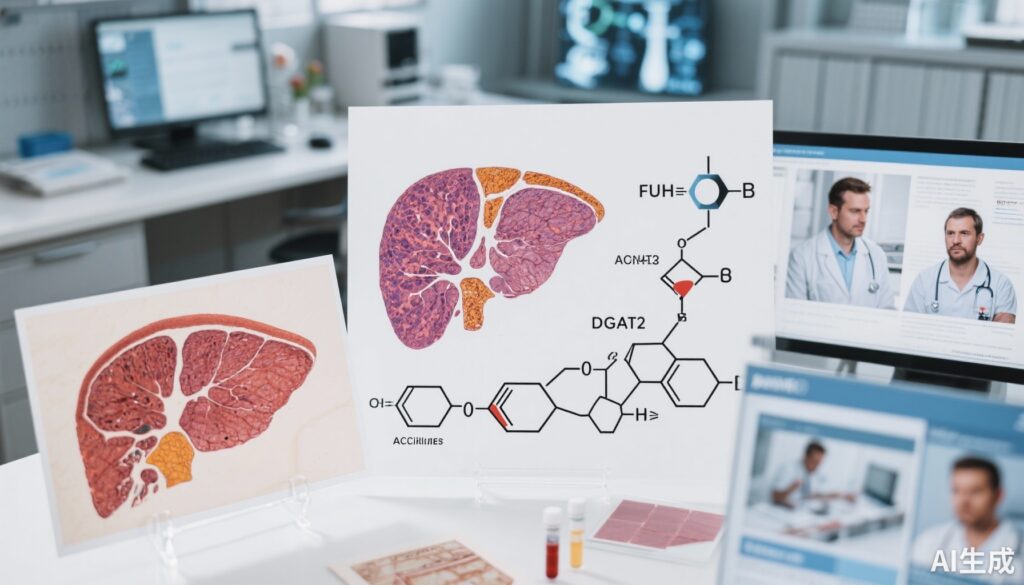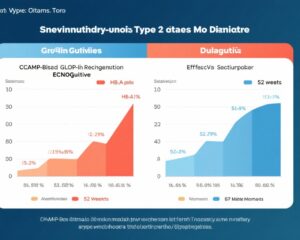Highlight
– Ervogastat plus clesacostat significantly improved resolution of metabolic dysfunction-associated steatohepatitis (MASH) without fibrosis worsening in patients with stage F2-F3 fibrosis.
– Ervogastat alone did not reach statistical significance over placebo for the primary composite endpoint.
– The combination treatment was associated with an unfavorable fasting lipid and apolipoprotein profile potentially related to ACC inhibition.
– Safety profile was generally tolerable with most adverse events being mild or moderate; no deaths were reported.
Study Background and Disease Burden
Metabolic dysfunction-associated steatohepatitis (MASH), a progressive form of nonalcoholic fatty liver disease (NAFLD), features hepatic steatosis along with inflammation, hepatocyte injury, and varying stages of fibrosis. MASH progression to cirrhosis poses substantial clinical morbidity and mortality risks, and currently, there is no approved pharmacotherapy specifically indicated for MASH. The disease burden includes increasing prevalence globally tied to metabolic syndrome, obesity, and diabetes mellitus.
Ervogastat, a diacylglycerol acyltransferase 2 (DGAT2) inhibitor, modulates triglyceride synthesis within hepatocytes, thus mitigating hepatic steatosis. Clesacostat, an acetyl-coenzyme A carboxylase (ACC) inhibitor, reduces de novo lipogenesis, another key pathway contributing to liver fat accumulation. However, ACC inhibition can increase circulating triglycerides, a lipid profile disturbance that DGAT2 inhibition may counterbalance. The MIRNA trial evaluated the therapeutic potential and safety of ervogastat alone and combined with clesacostat in patients with biopsy-confirmed MASH and moderate to advanced fibrosis (F2-F3).
Study Design
This phase 2, double-blind, double-dummy, randomized controlled trial was conducted at 198 clinical sites across 11 countries. Patients with biopsy-confirmed MASH at fibrosis stages 2 or 3 were randomized in equal ratio to receive one of the following treatment arms: ervogastat monotherapy at doses of 25 mg, 75 mg, 150 mg, or 300 mg twice daily; combination therapy of ervogastat 150 mg plus clesacostat 5 mg or ervogastat 300 mg plus clesacostat 10 mg twice daily; or placebo, administered for 48 weeks.
The primary composite endpoint at week 48 was the proportion of patients achieving either resolution of MASH without worsening of fibrosis, at least a one-stage improvement in fibrosis without worsening of MASH, or both. Patients missing follow-up biopsy data were imputed as non-responders. Stratification was employed based on baseline fibrosis stage (F2 versus F3). This rigorous biopsy-based endpoint aligns with current consensus on histological outcomes predictive of clinical benefits in MASH trials.
Key Findings
A total of 255 patients were randomized and treated, representing 73% of the originally planned enrollment. The placebo group (N=34) demonstrated a 38% composite response rate. Ervogastat monotherapy response rates ranged from 45% to 52% depending on dose, but none achieved statistically significant superiority over placebo based on 90% confidence intervals crossing zero.
In contrast, combination therapy showed pronounced benefits: 66% (23/35) in the ervogastat 150 mg plus clesacostat 5 mg group and 63% (19/30) in the ervogastat 300 mg plus clesacostat 10 mg group achieved the primary endpoint, corresponding to placebo-adjusted absolute differences of 27% (90% CI 7%-43%) and 25% (90% CI 4%-42%), respectively. These effects were driven primarily by improvements in MASH resolution without worsening fibrosis rather than fibrosis stage improvement alone, as the fibrosis improvement rates without MASH worsening were not significantly different from placebo across all groups.
Safety analyses revealed most adverse events were mild or moderate. The most commonly reported adverse event was inadequate control of diabetes mellitus, with comparable rates across treatment groups and placebo. Notably, the combination therapy group exhibited alterations in fasting lipid and apolipoprotein profiles considered potentially undesirable, consistent with previous observations involving ACC inhibition. Serious adverse events occurred in 7% of patients overall, with no fatalities reported. Frequency of serious adverse events was numerically higher in combination therapy groups, mandating careful monitoring in future studies.
Expert Commentary
The MIRNA trial provides important clinical insights into the emerging therapeutic class targeting lipid metabolism pathways in MASH. The positive signal seen with ervogastat combined with clesacostat underscores the potential advantage of dual pathway modulation—namely, combining DGAT2 and ACC inhibition to both decrease hepatic triglyceride synthesis and suppress de novo lipogenesis, with the added effect of mitigating ACC inhibitor-induced hypertriglyceridemia.
However, the absence of significant fibrosis stage improvement and the lipid perturbations observed warrant cautious interpretation. The lack of fibrosis improvement might reflect insufficient study duration or sample size, as fibrosis remodeling is a slow process. The safety profile, specifically related to metabolic perturbations, highlights the need for individualized risk-benefit assessment and suggests lipid parameters should be closely monitored in future investigations.
Limitations include the relatively smaller sample size, incomplete enrolment relative to planned recruitment, and conducting a single 48-week follow-up period. The generalizability to broader populations or other fibrosis stages remains to be established.
Conclusion
In adults with biopsy-confirmed MASH with moderate to advanced fibrosis, combination therapy with ervogastat and clesacostat demonstrated superior efficacy over placebo in achieving composite histologic endpoints of MASH resolution without fibrosis worsening at 48 weeks. Ervogastat alone did not significantly outperform placebo. Both treatment modalities displayed acceptable safety and tolerability profiles, with notable lipid-related effects in the combination therapy cohort.
The MIRNA study supports continued development of ervogastat, particularly in combination with clesacostat, as a promising therapeutic approach for MASH. Larger, longer-duration phase 3 trials are warranted to confirm efficacy, explore fibrosis reversal potential, and fully characterize the safety profile, especially the metabolic impact. The pursuit of combination strategies targeting complementary hepatic lipid pathways represents a rational direction for MASH therapeutics.
References
Wong VW, Amin NB, Takahashi H, Darekar A, Tacke F, Kiszko J, Rodriguez H, Nakajima A, Alkhouri N, Charlton M, Anstee QM. Efficacy and safety of ervogastat alone and in combination with clesacostat in patients with biopsy-confirmed metabolic dysfunction-associated steatohepatitis and F2-F3 fibrosis (MIRNA): results from a phase 2, randomised, double-blind, double-dummy study. Lancet Gastroenterol Hepatol. 2025 Oct;10(10):924-940. doi: 10.1016/S2468-1253(25)00128-1. Epub 2025 Jul 31. PMID: 40753985.



